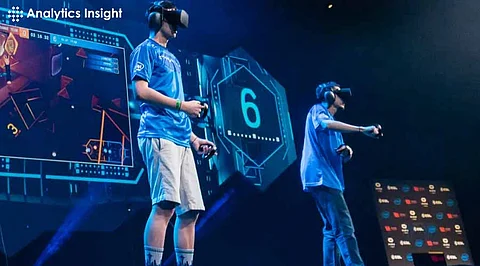

The eSports industry has seen unprecedented growth, attracting millions of fans, sponsors, and players worldwide. But with virtual reality (VR) technology becoming more advanced and accessible, a new horizon is emerging in the competitive gaming world which is VR eSports. This new type of video gaming competition is much like the physical training that athletes go through to get into the playing field.
In VR eSports, players are not only watching some action on a screen but are interacting physically and consciously in a 3D world. Making a promise to revolutionize eSports in its very core, this shift is going to have quite an impact.
Compared to other eSports games such as IGI, Counter-Strike, Fable, League of Legends or Fortnite, where such games have been played on big screens and include laptop keyboards and controllers, VR alters the complete circumstances completely. Thanks to VR headsets, sensors and controller players can not only move but also shoot and think tactically in the third dimension. Such an addition of physical engagement adds a new dimension of the game which qualifies VR eSports to be physical and mental games. The shift also helps make the fan experience more immersive as they can watch games within the virtual stadium.
Some VR eSports titles are already prevalent in the gaming industry currently. Online entertainment refers to sports games which are played in zero gravity, such as Echo Arena which entails the boat movement through an arena to score goals as fast as possible. The next successfully launched title, Pistol Whip, is a shooter that forces the player to play in time to the music for a semi-VR experience. The Virtual Athletics League (VAL) and events like the VR Master League are fostering a community around these titles, drawing in professional and amateur players alike.
VR technology reveals the potential that has been implemented in eSports. Unlike most computer games eSports, VR eSports brings the physical aspect into it because one must use their entire body to play it. All these new experiences of immersion and physical presence are due to improvements in VR hardware. Oculus, HTC Vive and PlayStation VR are ongoing improving their headsets, with higher screen, depth, and field resolutions, tracking and haptic feedback.
Despite its promise, VR eSports faces hurdles. VR hardware, including headsets, sensors, and controllers, can be costly, creating a barrier for some players. Furthermore, VR gaming entails a lot of space to move around in freely, which is not possible for all. Physical limitations also play a role; extended gameplay in VR can lead to fatigue and, for some, even motion sickness. For VR eSports to truly go mainstream, these accessibility issues need to be addressed, making the technology more affordable and comfortable for all users.
VR eSports requires both physical and mental strength, making it the only class of eSports where gamers are also athletes. Thus, players must devise abilities of not only psychomotor nature but also physical in terms of strength, stamina, and spatial. Given the progress in games and tournaments training and conditioning of VR eSports might come to look like traditional sports, adding another level of skill to the event.
Of course, one of the features that make VR eSports particularly interesting is the shift it brings to spectators. These shows allow fans to see games from the players’ point of view, and feel the game environment inside the game field. It is at this level that VO could entice a whole other market that would receive the novelty of live sporting events enlisted with an all-encompassing VR experience. Virtual spectating not only makes the game even more thrilling but enables them to do it in a way that cannot be done in virtual reality.
The combination of VR eSports gives the industry many opportunities. By integrating physical movement with competition in virtual reality, thus it is possible to capture the audience from both the computer game and sports analytics. Perhaps, these possibilities will promote new approaches to training and coaching for VR that will establish new positions for trainers and analysts.
Broadly speaking, there has been increased innovation in the field of VR technology and VR eSports is now closer to being a very important subgenre of the large and growing eSports community. If developers continue to enhance the tech behind the VR headsets and games, and become more professional leagues and tournaments that draw more players, then VR eSports may just be the next thing for competitive gaming. This demands a lot of physical and mental effort from players in games whose setting is in Virtual Reality environment.
As VR eSports continue to evolve, they are poised to redefine the boundaries between gaming and physical sports, pushing the industry into uncharted territory. By merging physicality, immersive technology, and the thrill of competition, VR eSports could become the future of competitive gaming, bringing a new era of engagement and excitement to players and audiences around the world.
